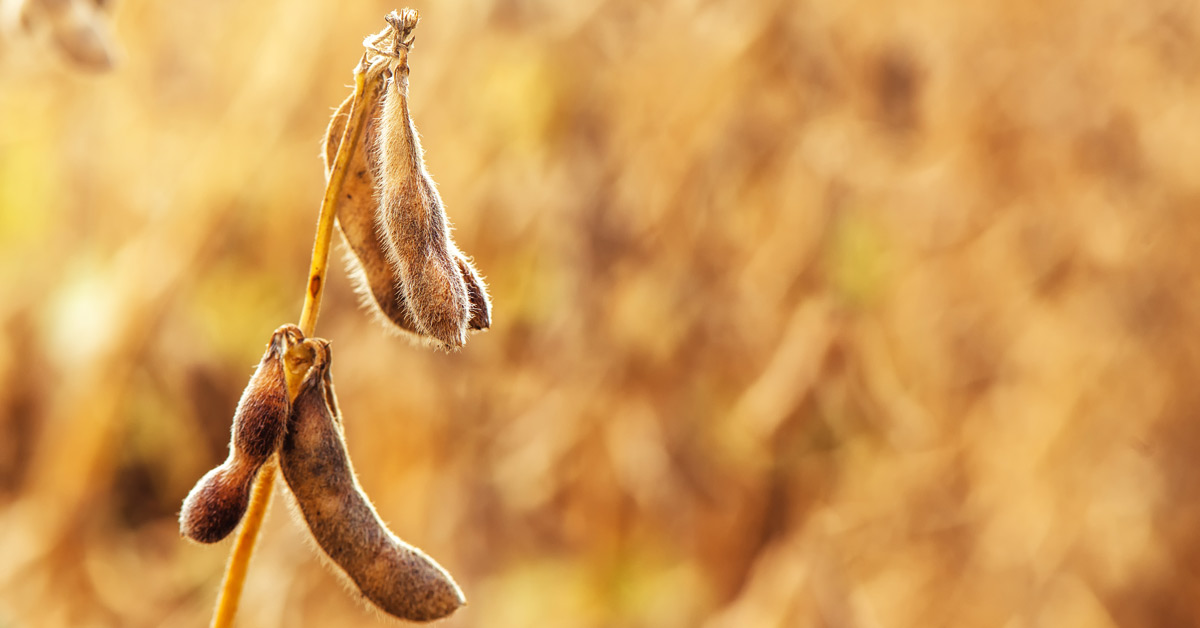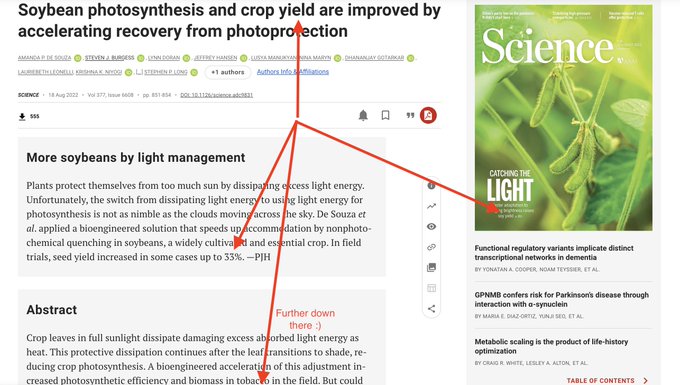
Yield trials for GMO photosynthesis-enhanced soybeans fail to convince. Report by Claire Robinson
Science Magazine recently published a paper reporting massive yield gains in rice, thanks to genetic engineering. The hype surrounding the paper was comprehensively debunked by Merritt Khaipho-Burch, a young scientist studying plant breeding. Even stalwart GMO boosters like Pam Ronald had to agree with her devastating takedown.
Now Science Magazine has done it again, publishing and heavily promoting a paper in which US-based scientists report that genetic engineering soybean plants to make photosynthesis more efficient has increased the total crop yield by 20%. News of this generated even more media excitement than the rice paper. But Khaipho-Burch has yet again burst the bubble of hype.
The genetic engineering approach
The genetic engineering approach was designed to interfere with the plants' photosynthesis process. Photosynthesis is a chemical process that uses energy from sunlight to turn carbon dioxide and water into sugars that fuel a plant's growth. In bright sunlight, plants switch into a protective mode and release excess energy as heat, to avoid damage to their cells. But it takes several minutes for a plant to switch out of "protective mode" and back into "fully productive growth mode". The scientists manipulated the genes responsible for this protective function and made their experimental soy plants "switch back" more quickly. The leaves of the GM plants thereby gained more photosynthesis time, which increased the total crop yield by an average of 24.5%, the scientists claimed.
"Global food security boost"
Their claim was lapped up uncritically by the mainstream media, with headlines such as the BBC's Food crops made 20% more efficient at harnessing sunlight, the Guardian's New GM soya beans give 25% greater yield in global food security boost and the New York Times' Scientists boost crop performance by engineering a better leaf dominating the narrative.
But the media are not entirely to blame for the hype. It started with the authors themselves titling their paper, "Soybean photosynthesis and crop yield are improved by accelerating recovery from photoprotection" and stating in the abstract that yield was increased "by up to 33%". They also invoked the standard "GM will feed the world" line, claiming that the results validate "increasing photosynthetic efficiency as a much needed strategy toward sustainably increasing crop yield in support of future global food security".
Khaipho-Burch was unimpressed. She launched a Twitter thread explaining why the claimed yield increase was "misleading".
None of the yield claims are justified
While conceding that this is "a cool paper on the physiology of photosynthesis and shading", she cautioned that "the yield trials lack sufficient replication to make any claims. The experiment was grown over 2 years ('20, '21) in just 1 environment in Illinois. Solid yield trials are tested in 15-20 target location-year combos in numerous genetic backgrounds."
Only 340 plants were grown – as Khaipho-Burch says, a "really small" sample – and the GM construct was only tested in one soybean line, a high performing line called Maverick.
Khaipho-Burch explains that the scientists' yield estimates are around 5 tonnes per hectare (t/ha) for the untransformed Maverick soybean line* and 7 t/ha in their best GM line. This is where the 33% yield increase comes from: One environment in one year with one line.
The average increase of 24.5%, though a lot smaller than the 33% figure cited in the paper's abstract, seems impressive at first glance. But Khaipho-Burch writes that statistically speaking, it was only a "marginally significant" increase – and, given the scientists' field design and management practices, the yields were comparable with state-wide trends in Illinois, where the trials were carried out.
While the experiment was conducted over two years, in one of those years a storm hit their field and caused the plants to lodge (fall over and not right themselves). Khaipho-Burch comments that "this time all their high-yielding lines yielded LESS" than the untransformed Maverick soybean line. She adds, "Weather happens and they do mention this. However, the emphasis in their discussion and in the news don’t hype" the figure in the supplementary data that shows this failure.
"Unreplicated results make effects hard to believe"
Khaipho-Burch's verdict? "Replication is key in science and unreplicated results make effects hard to believe." She adds, "While these genes definitely hold some promise, as a plant science community we have to stop with 'click-bait' yield science. We mislead the public, other scientists, and policymakers who allocate funding towards our research. In plant breeding, we need replicated field trials in numerous backgrounds in target growing environments. Studies that do not replicate appropriately are not going to cut it."
Support for Khaipho-Burch from unlikely quarters
Just as with Khaipho-Burch's debunking of the previous round of hype over the GM rice yield gains, her arguments have gained support even from GMO boosters.
For example, Linus Blomqvist, the former director of food and agriculture at the avidly pro-GMO ecomodernist Breakthrough Institute, warned in a sober tweet: "If you see research that claims to have boosted a crop's potential yield by more than like 10% it's probably compared to a misleading baseline or only valid under very narrow conditions so it doesn't translate to higher yields in the real world".
Author replies to criticism
One of the paper's authors, Steven Burgess of the University of Illinois, responded to Khaipho-Burch's criticisms.
He admitted that "Excellent points have been made about the need for extensive field testing over multiple years and at multiple sites to determine the impact on yield, in addition to concerns about the way that science is reported. They are valid points."
He also tweeted a series of caveats that emphasised the limitations of his study:
* This work is a proof of principle [i.e. proof of concept]. There is a long way to go, and multi-site, multi-year comparisons are required before the exact impact on yield is determined.
* We know from other studies that when this trait was introduced (but total photoprotection was increased), yields were decreased in potato.
* For unknown reasons this strategy didn't work in Arabidopsis, a plant often used in GM experiments: "It demonstrates that we don't fully understand what is going on."
* There is large variation between species. Some crops may already be optimised for light harvesting so it will be important to choose the crops that this trait is tested in.
* Limitations also change in response to environmental conditions and development stage of the plants.
Burgess concludes, "In summary, the paper should be taken as [a] starting point that provides further evidence photosynthesis can be improved in crops, further research is needed to understand how and when this trait works and there are many challenges and opportunities ahead."
Science Magazine accused of misconduct
A Twitter account principally run by Thomas Björkman, Professor in the School of Integrative Plant Science at Cornell, thanked Burgess for his explanation and blamed Science Magazine for the evidence-free hyping of the paper: "It's important not to be tempted into overstating the result. The yield claim in the Science press release is, in my estimation, not puffery but misconduct in that it makes an improbable claim for which there is no evidence."
But Guillaume Lobet, an assistant professor at the Université catholique de Louvain in Belgium, placed the blame for the misleading coverage on both the journal and the authors. He tweeted, "Just to add my 2 cents, I think that in addition to how science is *reported* (by third party media outlets), we also can reflect on how it is *advertised* in the first place... What I mean is that the 'yield' argument, that was discussed in different threads (and might not be the strongest aspect of the paper, as far as I understood), is highlighted on the cover of the journal, the title of the article, the journal highlight and in the paper abstract."

Khaipho-Burch agreed that the onus is fully on the authors to highlight limitations of their study design within the paper itself. She tweeted to Burgess: "Small yield trials are okay, BUT we need to be cautious to highlight the limitations of our experimental design and results w[ith]in our papers and the media, because what most folks will remember from this headline is the '33% yield increase' and not all the limitations stemming from the lack of environmental and biological replication that is tested within larger, rigorous yield trials. There's no substitute for large yield trials to verify genes and make these yield claims. Field trials should be budgeted for in grants with the same importance as molecular or publication costs."
Ed Buckler, a plant geneticist with the USDA Agricultural Research Service, provided estimates for how much it would cost to run replicated field trials to verify yield estimates, and showed, as Khaipho-Burch pointed out that "It's not that much in relation to the cost of an entire project." Which leaves us with the question: Given that it costs peanuts, why isn’t it being done?
The level of acclaim for evidence-free GM claims that has been generated in not just papers like the New York Times but in journals like Science suggests an obvious answer.
What else does the gene manipulation do?
Finally, we should bear in mind that the way this particular genetic manipulation works is by disrupting the plant's self-protective mechanism. What other unwanted effects might this disruption cause? Might it affect the plant's adaptation to environmental stresses? Or could the altered light-harvesting behaviour of the plant – or the genetic manipulation itself – result in compositional changes that might prove to be toxic or allergenic?
The authors fail to show any curiosity about these factors in their paper.
Yield increases irrelevant to solving hunger
Even if GM-induced yield increases were proven to be real, repeatable, and safe for health and the environment, focusing on yield as a solution to the global hunger problem is entirely missing the point, as several commentators have pointed out.
Dr Jonathan Latham has written the definitive explanation of why "There is no global or regional shortage of food. There never has been and nor is there ever likely to be." Even in countries where hunger is rife, he points out, there is a surplus of food production: "Granaries are bulging, crops are being burned as biofuels or dumped, prices are low, farmers are abandoning farming for slums and cities, all because of massive oversupply."
Commenting directly on the new study, the climate and environmental scientist Dr Jonathan Foley tweeted that while the authors claim that "we can boost food production by tinkering with photosynthesis", much "bigger levers" exist already: "cutting food waste, shifting diets, and helping farmers". Foley asks, "Why are we missing the elephants in the room while chasing the mice?”
As GM Freeze tweeted in response to the new paper, "People aren't hungry because of some inherent flaw in photosynthesis – they're hungry because they are poor! We need to focus on reducing food waste and distributing resources fairly, NOT GMO vanity projects. We aren't cleverer than nature."
* The untransformed Maverick soybean line is called "WT", short for "wild type", in Khaipho-Burch's Twitter thread and in the scientists' paper.